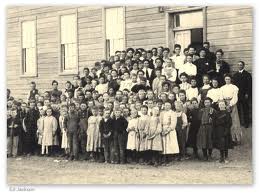
Georgia's first compulsory school attendance law was passed in 1916. Photo from georgiainfo.galileo.usg.edu.
For the last 150 years, we have assumed “public education” meant publicly funded education, but in this new age of customized teaching and learning this definition is too narrow. Today, it’s more useful and accurate to define public education as all learning options that satisfy mandatory school attendance laws, including those that don’t receive public funding, such as private schools and home-schooling.
Education - especially public education - has taken many forms in the United States over the last 300 years. According to Pulitzer Prize winning education historian Lawrence A. Cremin, in the 1700s education encompassed institutions “that had a part in shaping human character - families and churches, schools and colleges, newspapers, voluntary associations, and … laws”, while public education referred to formal instruction in public settings outside the home.
Public teaching became increasingly common in the latter half of the 18th century, and by the early 19th century most communities had at least one free school open to all white children. These free schools, which operated independently much like today’s charter schools, became known as common or public schools. They combined with religious schools receiving public funding to educate the poor to comprise public education. As Cremin notes, in 1813, most New Yorkers saw publicly-funded religious schools “as public or common schools.”
Over the next few decades, public funding for religious schools - most notably Catholic schools - became more contentious and rare. By the mid-1800s, free public schools and public education had become synonymous. Schools not receiving public funds were called private schools, even though they provided public instruction outside the home.
The birth of public education as we know it today occurred during the 1840s and ‘50s.
Catholic immigrants were flooding into urban areas and community leaders needed an effective and efficient way to assimilate these immigrants into a Protestant-dominated republic. Free public schools that were open to all whites and taught Protestant values were the obvious solution.
The country’s first mandatory school attendance law passed in 1852 in Massachusetts, a state that was being inundated by newly arriving Catholics. Over the next 50 years, every state eventually followed Massachusetts’ lead, with Mississippi being the last state to mandate school attendance in 1918. In an attempt to eliminate all Catholic education, Oregon passed a Ku Klux Klan supported initiative in 1922 requiring all children to attend Protestant-controlled public schools. But the U.S. Supreme Court ruled this initiative unconstitutional in 1925, giving parents the ultimate authority - within the constraints of each state’s mandatory attendance law - to determine how their children are educated.
The industrial expansion of the late 1800s led to more changes in public education. As immigration into urban areas caused city populations to explode, public school managers embraced the promised efficiencies of assembly lines, standardization, mass production, and command-and-control management. This industrialization of public schooling accelerated in the early 20th Century and is still the dominant organizational model today. But now, another transformation is occurring.
Public education is currently transitioning from a one-size-fits-all model of schooling to customized learning. As this shift unfolds, what constitutes public education is again changing.
Over the last several years, many reformers, including those of us at redefinED, have argued that public education is being redefined. It is no longer a closed system of neighborhood schools owned and managed by local school boards that assign students to schools by zip code. Instead, public education is evolving into an open and diverse network of structured learning environments, many of which are privately-owned and managed, that students can access using public funds. I still support this emerging new definition, but with one caveat. I no longer believe schools need to receive public funding to be considered part of public education. I now think public education is better defined as education that satisfies mandatory school attendance laws, regardless of whether this education is publicly or privately funded.
My rationale: attendance laws exist to serve a public purpose, and public education is the vehicle states have created to achieve this purpose. Therefore, any education that satisfies a state’s attendance law is public education, while education that does not satisfy this law is not. In Florida, for instance, this means public education includes homeschooling and private schools, since attending these schools meets the state’s attendance requirements. Conversely, publicly-funded after school tutoring programs run by the Boys and Girls Clubs are not public education since attending them does not satisfy attendance laws.
Aligning what constitutes public education to the purpose underlying school attendance laws should enhance our dialogue about how best to regulate customized learning. For example, should all students who are meeting a state’s attendance law be required to master the same learning standards? Should home and private school students be required take the same state exams as charter and district school students? Or, if home-school parents can exempt their children from taking these exams, should parents in magnet, virtual and neighborhood schools have this same option?
As customization increasingly replaces the industrial assembly line as public education’s preferred organizational model, we’ll need to redefine public education accordingly. If history is any guide, this redefinition will be one of many over the next 300 years.
Writer’s note: The Lawrence A. Cremin quotes come from his book, American Education: The National Experience, 1783-1876 (page 2 and page 164, respectively).